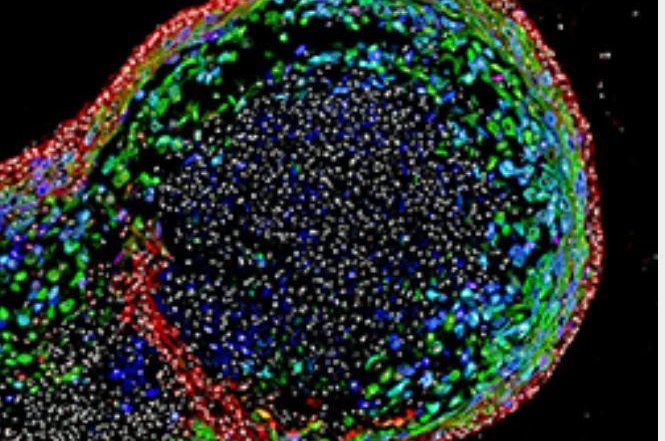This confocal microscopic image shows a 2-month-old human esophageal organoid bioengineered by scientists from pluripotent stem cells. It is about 700 micrometers in size. Photo courtesy of
Chicago Children's Hospital Medical Center
Sept. 20 (UPI) -- For the first time, researchers have bioengineered human esophageal tissue entirely from pluripotent stem cells.
Researchers at the Cincinnati Children's Hospital Medical Center for Stem Cell and Organoid Medicine, or CuSTOM, developed the cells in their quest to create an entire gastrointestinal system. The scientists, who published their findings Thursday in the journal Cell Stem Cell, also hope their research leads to personalized diagnostic methods to treat or cure GI disorders.
Cincinnati Children's scientists and their multi-institutional collaborators already have used pluripotent stem cells to bioengineer the human intestine, stomach, colon and liver.
"Disorders of the esophagus and trachea are prevalent enough in people that organoid models of human esophagus could be greatly beneficial," lead investigator Dr. Jim Wells, chief scientific officer at CuSTOM, said in a press release. "In addition to being a new model to study birth defects like esophageal atresia, the organoids can be used to study diseases like eosinophilic esophagitis and Barrett's metaplasia, or to bioengineer genetically matched esophageal tissue for individual patients."
The esophagus is a muscular tube that actively passes food from the mouth to the stomach.
Esophageal atresi, a narrowing or malformation of the esophagus caused by genetic mutations, is among congenital diseases of the organ.
People later in life can get esophageal cancer and gastroesophageal reflux disease. A rare ailment called achalasia affects the muscles of the lower esophagus, preventing the contraction of the organ and the passage of food.
A more precise understanding of the genetic and biochemical mechanisms behind their cause can be utilized by growing from a person's own cells.
They used human PSCs in manipulations of genetic and biochemical signals.
The gene Sox2 and its associated protein, which are already known to trigger esophageal conditions when their function is disrupted, were studied.
Researchers used mouse, frog and human tissue cultures to identify other genes and molecular pathways regulated by Sox2 when the esophagus is forced.
During critical stages of embryonic development, the Sox2 gene blocks the programming and action of genetic pathways that direct cells to become respiratory instead of esophageal. Specifically, Sox2 protein inhibits the signaling of a molecule called Wnt and promotes new esophageal tissues an their survival.
The complete loss of Sox2 during the developmental process in mice resulted in esophageal agenesis, which is when the esophagus terminates in a pouch and does not connect to the stomach.
The researchers created fully formed human esophageal organoids to a length of about 300-800 micrometers in about two months. The new tissues were compared biochemically to esophageal tissues from patient biopsies, with the researchers finding they were similar in composition.
They plan to adapt their process to the progression of specific diseases and congenital defects affecting the esophagus.















